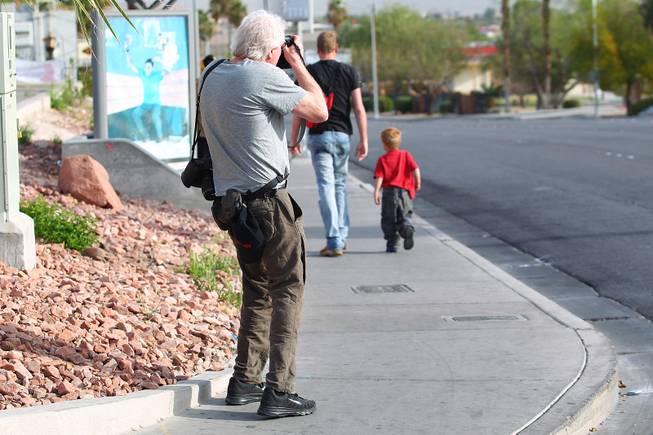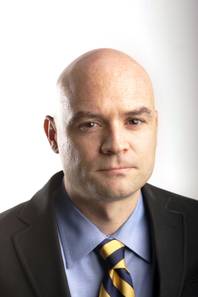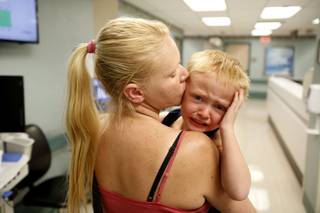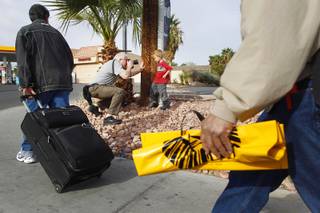
Sam Morris / Las Vegas Sun
New York-based photographer Craig Blankenhorn photographs Tom and his son Kaleb heading to a bus stop as part of his larger project focusing on youth and homelessness Wednesday, March 27, 2013.
Monday, April 1, 2013 | 2 a.m.

J. Patrick Coolican
Sun Archives
Craig Blankenhorn has spent most of his professional life on film and TV sets — “Sex in the City” and “The Sopranos” among them — shooting photos for the big advertising displays you see in newspapers and magazines.
But now he’s also traveling the country, documenting the lives of homeless families — people like Tom, Angela and little Kaleb, who is one of 1.6 million homeless kids in the United States.
On this day, Tom is practically sprinting up East Washington Avenue — with 4-year-old Kaleb on his shoulders — to go check on his fiancee, Angela, who is feverishly sick in their room at the Best Western.
Blankenhorn, carrying a couple of Canon EOS 5D Mark III cameras over his shoulders, is run-walking to keep up with Tom, not wanting to miss the scene.
As we hustle up the hill to get back to the Best Western, Blankenhorn whispers to me: “See what I mean? It’s a true love story.”
He’s talking about Tom and Angela. He met the couple last week through a contact at Catholic Charities.
Tom and Angela, who asked that their last names not be used because they don’t want to embarrass their family, came to Las Vegas with little but faith and hope.
They had been living in the Salt Lake City area, subletting the finished basement of a house, only to learn the people they were paying were using the money for heroin, causing everyone to get evicted.
They bounced around cheap motels. Without a car, they lost their jobs. They used the last of their money to get to Vegas, where Tom has family he hoped would help him out.
His brother gave him a little money when they got here, then told Tom to get lost.
Thanks to Catholic Charities, they are temporarily ensconced at the Best Western on Main and Washington, which seems to reserve the back of it farthest building for families like these.
Blankenhorn, the photographer, comes into the picture because he contacted me recently looking for help documenting homeless families here. The truth is, he doesn’t need much help. For more than a year, he has worked streets and weekly motels, shelters and churches in Tampa, Fla., and Scottsdale, Ariz.; Janesville and Beloit, Wis.; Kissimmee, Fla., and Essex County, N.J.; and become quite familiar with homeless families.
As he would quickly learn, though, there’s no place like Las Vegas.
• • •
We’re here at the Best Western early in the morning. Blankenhorn likes to hang out with families for long stretches — often taking no photos for an hour or two — so he can build trust and get the images of vulnerability that come after exhausting days jumping through bureaucratic hoops, finding food and applying for jobs and doing it all by bus or on foot.
Earlier in the week, Tom was up all night with Kaleb, who was running a fever.
This morning, it’s Angela who is sick. She’s munching on a sandwich, but it’s not sitting well; she runs to the bathroom and wretches.
There’s no mini-fridge, so the food money they got from Tom’s brother didn’t yield much that’s fresh. They’re resourceful, though. A half-gallon of milk sits in an ice bucket. Tom uses a microwave in the motel’s restaurant.
Luckily, little Kaleb is feeling better, happy with “SpongeBob SquarePants” on the TV and his dad’s tickling.
Angela will stay in bed and try to rest while Tom goes out to get a health district food safety card that will allow him to ply his craft as a cook. He has worked in restaurants for 17 years, since he was 15.
“Okay cracker, where’s your socks at?” Tom says to Kaleb.
We walk east on Washington toward the bus, with Kaleb on Tom’s shoulders.
Blankenhorn gets right up on his subjects, especially Kaleb, who treats the camera like a man seeing himself reflected in a river for the first time.
On the walk, Tom recalls his mom, also named Angela. She was a cocktail server at the Rio but died at 43 of cirrhosis.
He grew up in Las Vegas, graduated from Cheyenne High School and left for Utah in 2002. “It was a bad place to grow up,” he says of his hometown.
Since returning to Las Vegas, however, “This town’s been really good to us,” he says. He has spoken too soon.
We catch the bus, but before we get far, Tom takes a call from Angela, who is feeling worse and needs him.
“Stop the bus!” he yells just as the bus is leaving a stop.
This is when he puts Kaleb on his shoulders and starts really huffing up the hill as Blankenhorn and I try to keep up.
“I can’t let her get too sick,” Tom says. A bad break, all the same. No food safety card means no restaurant job.
• • •
The primary characteristic that distinguishes the people he’s met, Blankenhorn says, is that they have nothing to fall back on — no family or social network like the rest of us rely on when we screw up or when life just goes sideways.
This tracks with what I’ve found reporting on poor families: Their bad decisions — and they make a lot of them — are amplified by their bad luck, and there’s no one there to catch them when they inevitably fall.
Blankenhorn has also learned about the cycle of poverty: Kids who never had a role model, never saw an adult get up and go to work every day, go on to have kids of their own.
Missy, a young mother he photographed in Tampa for The New York Times, was sexually abused as a toddler and then shuttled around foster homes before getting tossed out when she turned 18. No one taught her how to brush her teeth, so they were all gone, which led one big-box retailer to tell her they could not hire her. Now she has a young son of her own.
Back at the Best Western, Tom is comforting Angela. Blankenhorn wants to stick around in case Tom is going to take his fiancee to the emergency room.
Blankenhorn and I hang around outside, and I tell him how amazed I am at how quickly he’s won the trust of Tom, Angela and Kaleb.
It turns out that Blankenhorn, who is 60, has lived the kind of textured life that helps him connect with people.
He volunteered for the Army and was a whisker away from Vietnam but wound up in Germany. After that, there was the University of Oregon and the oil fields and fishing boats to pay for it.
He hitchhiked across the country three or four times in the 1970s, camera in tow. “When you’re doing that, you better form a relationship real quick,” he says with a laugh.
He was a New York City taxi driver in the 1980s before finding his niche shooting still photos for movies and TV, though he’s always had his passion projects like this one. That need only grew when the love of his life died six years ago after 25 years of marriage.
So, once every three months or so, he heads out to a new city to find the stories of homeless families. “And then you get emotionally involved in the families. And especially the kids. It’s incredibly sad when you think about the children. What chance do they have? The parents always say, ‘The kids don’t deserve this.’ And they’re right.”
• • •
Tom brings Kaleb outside to play. Kaleb reaches up with his tiny hand and knocks on the door of a room down the way, where another family is living. Kaleb has friends — two little boys come out, and now the three of them are as thick as thieves, having a blast in the parking lot of the Best Western.
Blankenhorn loves this scene and is desperate to photograph it, so he retrieves release forms for the other mom, Miliam Quintanilla, who has a little baby in addition to her two boys now playing with Kaleb.
“Kiss me, I’m Irish,” the baby’s T-shirt reads. Blankenhorn is like a soldier, on his stomach, as low as he can get, capturing the face of a child who lives, for now, at a Best Western in Las Vegas.
Quintanilla has Tylenol for Angela, which is a lifesaver. Angela happily agrees to watch the kids while Quintanilla heads to the corner store. Even in the worst circumstances, human beings can show a fierce desire to find connection.
It’s time for me to take off, but Blankenhorn stays.
He continues to capture images of both families all day.
Then later that night, he calls me, flustered. Tom has been stabbed in the gut.
Later, we would learn that Tom went out for what’s known as a loosey, a single cigarette. There was some kind of verbal confrontation with a stranger near the motel, and when Tom returned from the store, he was stabbed at the corner of Main and Washington.
He was taken to University Medical Center in critical condition. After four hours of surgery, he is now recovering and should return to full strength. The news got four sentences in the Sun, based on a brief Metro Police press release.
The next morning, Blankenhorn caught up with Angela and Kaleb, who were going to the hospital to see Tom. Here the photographer faced a classic conundrum of journalistic ethics: Could he give them a ride to the hospital? Time and again, he wants to help his photo subjects, but he can’t for fear of turning real situations into artificial photo-ops.
“This is killing me about the project. What do you do?” he pleads. The story subjects, he says, are always understanding.
So Angela and Kaleb get on the bus.
Blankenhorn relates the scene to me later: At the hospital, Tom isn’t very coherent. He whispers to his fiancee and son, “I love you both.”
Blankenhorn captures compelling images of a little boy suddenly introduced to the world of human chaos and violence.
When I talk to Blankenhorn a couple of hours later, he says, “I plan on sitting in my hotel room and staring at the wall for a while.”
He is exhausted. And I can hear traces of despondency, a skepticism that anything can really be done. “I’m trying to document it and naively thinking I’m going to get somebody to do something about it.”
He’s sunk $35,000 of his own money into the project, hoping for nothing more than to show the forgotten.
His other work, shooting movie and TV stars, he says, “Pays the bills but doesn’t fill the soul.”
His photography, on the other hand, just might save a few, if we’re lucky.



Join the Discussion:
Check this out for a full explanation of our conversion to the LiveFyre commenting system and instructions on how to sign up for an account.
Full comments policy